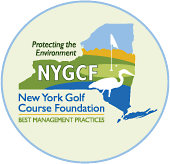Search results for ""
| Results 21 - 30 of 134
|
Page 3 of 14
|
|
Sorted by: Date | Sort by: Relevance
|
Results per-page: 10 | 20 | 50 | All
|
May 6, 2019 by NYS BMP Drift when it comes to pesticide applications is something to be avoided, as it can potentially cause not only water quality impacts, but also damage to susceptible off target crops. In addition, a lower than intended rate of pesticide will be applied to the turfgrass, thus reducing its effectiveness. To avoid drift, the first step is to know the difference between There are two types of drift airborne (spray) drift and vapor drift and the contributing factors to each. Spray Drift The U.S. Environmental Protection Agency defines pesticide spray or dust draft as “the physical movement […]
May 6, 2019 by NYS BMP Most people can easily recognize a monarch butterfly, but did you know that their numbers have suffered dramatic declines in the last 40 years? Habitat loss in both their summer and overwintering locations has played a major role in this decline. A number of recent conservation efforts have been put in place to help protect monarchs and their habitat. One such program is aimed directly at golf courses: Monarchs in the Rough, a new program sponsored by Audubon International and the Environmental Defense Fund. Because monarch butterflies only lay their eggs on milkweed, and their caterpillars […]
April 23, 2019 by NYS BMP · The New York Golf Course Foundation (NYGCF) is a newly launched non profit to promote sustainable golf management efforts in New York State. This new organization is an evolutionary step for the New York State Best Management Practices (BMPs) project begun in 2012 that established the state’s first golf industry BMPs. The foundation’s mission is to continue and expand upon the work of the BMP committee, raise the profile of the state’s golf industry with respect to its environmental sustainability efforts, and to fundraise to provide a sustainable source of revenue to continue these efforts. Scientists […]
April 22, 2019 by NYS BMP At Whippoorwill (country club?) buffer strips around ponds on the property had become overgrown and encroached upon by invasive species. Because of the rocky, steep hillside, chemical control was not an option and physical removal difficult. To control the growth, an innovative approach to vegetation removal was utilized: goats. Goats are browsers who prefer brushy vegetation and vines (including poison ivy) versus other species like sheep who prefer to graze on grass. Goats are also unique in weed seeds are left unviable after being digested and will not grow out of their excrement. Green Goats, a […]
April 22, 2019 by NYS BMP · Spills happen and being prepared can make the difference between being able to safely contain the spill and not. Have you checked your spill kit recently to make sure you have everything you may need? The following is a checklist for what should be in your spill kit at a minimum to make sure a small issue does not become a bigger problem: Gloves (nitrile, at least; foil barrier laminate better) Tyvek® coverall Goggles Temporary storage container for spill Sorbent pads and/or socks Loose absorbent (SlikWik®, vermiculite) Sweeping compound Warning sign or caution tape Chalk (for […]
April 10, 2019 by NYS BMP Spring is a great time to consider adding native plants to your facility to create additional habitat for pollinators and review the availability of nesting sites for these species. Pollinator habitat on the golf course includes both areas planted specifically with pollinators in mind and existing out-of-play areas. One of the most effective BMPs for protecting water quality also protects pollinator habitat, i.e., leaving a low- or no-management buffer strip around water courses and bodies of water. To add habitat for pollinators, add a diversity of blooming plants of different colors and heights that […]
February 17, 2019 by NYS BMP · Since publishing the Best Management Practices for NYS Golf Courses document and this website, the NYS BMP committee has focused on outreach and education efforts to promote the acceptance and implementation of BMPs in New York State’s golf industry. As part of these efforts, the committee surveyed the state’s golf course professionals to conduct a formative assessment of BMP concepts and a survey of BMPs as implemented on NYS golf courses. This survey was conducted in 2015 and early 2016 with a response window of four months. Once the survey period ended, the results were analyzed to […]
May 3, 2018 by NYS BMP · Assessing soil health is a critical aspect of best management practices implementation, as underscored in the BMP statement: Determine accurate supplemental nutrient needs based on soil chemical and physical analysis. On sand-based areas, consider foliar testing as a diagnostic tool. The soil on your property has enormous environmental, and ultimately, economic value. You cannot implement a fully aligned BMP program until soils are properly assessed. Soil health, by definition, includes the physical, chemical and biological properties of the soil. Management efforts typically focus primarily on maximizing the parameters in each of these categories for agricultural crop […]
April 16, 2018 by NYS BMP · Visit the NYS BMP Youtub channel to view the new case study video on the low cost washpad demonstration conducted at Locust Hill Country […]
March 21, 2018 by NYS BMP · As winter fades and the Spring rains arrive, a significant amount of water will flow along the surfaces of our golf courses and into wetlands, streams, rivers, lakes, and the spectacular estuaries of Long Island. In fact, New York State is associated with more than 15 individual watersheds (see inset to find your watershed). In some parts of the world, regulatory agencies can impose strict water quality reporting requirements on land managers. In fact, strict water quality reporting has been considered within the Chesapeake Bay Watershed, the Susquehanna River Watershed, and is undoubtedly of interest to […]
